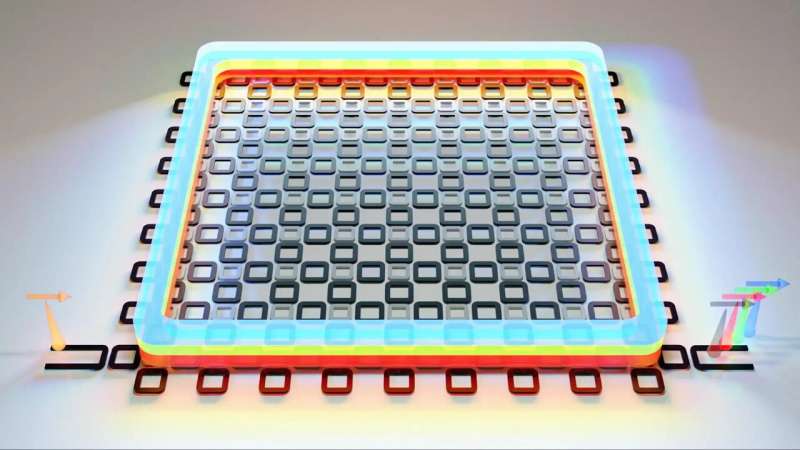Science
Researchers Develop New Photonic Chips for Color Conversion

Researchers at the Joint Quantum Institute (JQI) have developed innovative photonic chips capable of converting laser light into multiple colors on demand, significantly advancing the field of integrated photonics. This breakthrough, described in the journal Science on November 6, 2025, addresses a longstanding challenge in creating compact light sources suitable for integration with existing technology.
For decades, scientists have aimed to design chips that can transform a single color of laser light into a spectrum of colors. Such capabilities are essential for applications in quantum computing and precision measurements. The newly developed chips achieve this conversion without the need for active inputs or complex adjustments, marking a substantial improvement over previous technologies.
Understanding Photonic Chips and Their Functionality
Photonic devices manipulate individual photons, the fundamental particles of light, through processes resembling those used in electronic devices. The new chips operate differently from traditional prisms, which merely split light into its constituent colors. Instead, these chips generate entirely new colors from an incoming laser beam, conserving space and energy by eliminating the need for multiple lasers.
The ability to create new frequencies of light on a chip relies on nonlinear interactions—an area of study that researchers have been exploring for decades. Unlike linear interactions, which only bend or absorb light without changing its frequency, nonlinear interactions occur when light is concentrated to the extent that it alters the behavior of the device itself. This feedback mechanism can produce a wide range of frequencies, useful for various applications including measurement and synchronization.
Despite the potential of nonlinear effects, they are typically weak. Historical observations, such as the landmark discovery of second harmonic generation in 1961, highlighted the challenges scientists faced in harnessing these effects. Over time, techniques have evolved, with modern researchers employing precisely engineered chips featuring photonic resonators that enhance these nonlinear interactions.
Advancements in Frequency Generation
The research team, led by Mohammad Hafezi, a Minta Martin professor of electrical and computer engineering at the University of Maryland, has made strides in overcoming the limitations of previous methods. They discovered that by using an array of tiny resonators, they could produce second, third, and even fourth harmonics from an incoming laser with a frequency of approximately 190 THz, commonly used in telecommunications.
The breakthrough lies in the structure of these resonator arrays, which feature both fast and slow timescales of light circulation. This dual timescale approach enhances the likelihood of meeting the necessary conditions for frequency-phase matching, allowing the chips to operate efficiently without active compensation. In previous designs, researchers faced challenges in achieving this balance, often compromising one frequency generation for another.
The team conducted tests on six different chips manufactured from the same silicon wafer. Each chip successfully generated a range of harmonics, producing red, green, and blue light from the original laser input. In contrast, traditional single-ring devices equipped with active compensation yielded limited results, demonstrating the effectiveness of the new arrays.
The implications of this research extend beyond academic interest. The ability to generate new frequencies of light efficiently on a chip could transform applications in metrology, frequency conversion, and nonlinear optical computing, all while simplifying design processes and reducing the need for additional power supplies.
The researchers assert that their findings could lead to significant advancements in integrated photonics. As Mahmoud Jalali Mehrabad, the lead author of the study, noted, “We have simultaneously relaxed these alignment issues to a huge degree, and also in a passive way.” The results promise to enhance the reliability and efficiency of photonic devices, paving the way for new innovative applications in the future.
This research was conducted by a collaborative team, including Kartik Srinivasan, Yanne Chembo, and other contributors from JQI and the University of Maryland. The study represents an important milestone in the ongoing development of photonic technology, with the potential to impact various sectors reliant on precise light manipulation.
-

 Technology5 months ago
Technology5 months agoDiscover the Top 10 Calorie Counting Apps of 2025
-

 Health3 months ago
Health3 months agoBella Hadid Shares Health Update After Treatment for Lyme Disease
-

 Health3 months ago
Health3 months agoErin Bates Shares Recovery Update Following Sepsis Complications
-

 Technology4 months ago
Technology4 months agoDiscover How to Reverse Image Search Using ChatGPT Effortlessly
-

 Technology1 month ago
Technology1 month agoDiscover 2025’s Top GPUs for Exceptional 4K Gaming Performance
-

 Technology3 months ago
Technology3 months agoElectric Moto Influencer Surronster Arrested in Tijuana
-

 Technology6 days ago
Technology6 days agoOpenAI to Implement Age Verification for ChatGPT by December 2025
-

 Technology5 months ago
Technology5 months agoMeta Initiates $60B AI Data Center Expansion, Starting in Ohio
-

 Technology5 months ago
Technology5 months agoRecovering a Suspended TikTok Account: A Step-by-Step Guide
-

 Health5 months ago
Health5 months agoTested: Rab Firewall Mountain Jacket Survives Harsh Conditions
-

 Health3 months ago
Health3 months agoAnalysts Project Stronger Growth for Apple’s iPhone 17 Lineup
-

 Lifestyle5 months ago
Lifestyle5 months agoBelton Family Reunites After Daughter Survives Hill Country Floods




















